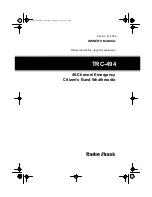
22
Figure 16: Rain gauge sensor mounting with screws installation diagram
Note:
Use the bubble level beside the rain sensor as a guide to verify that the
sensor is leveled. Use shims as necessary to achieve level installation.
4.4
Best Practices for Wireless Communication
Wireless (RF) communication is susceptible to interference, distance, walls
and metal barriers. We recommend the following best practices for trouble
free wireless communication between both sensor packages and the base
unit:
Indoor/outdoor sensor placement:
The sensor will have the longest
reach for its signal when mounted or hung vertically. Avoid laying it
down on a flat surface.
Electro-Magnetic Interference (EMI)
. Keep the base unit several feet
away from computer monitors and TVs.
Radio Frequency Interference (RFI).
If you have other devices
operating on the same frequency band as your indoor and/or outdoor
sensors and experience intermittent communication between sensor
package and base unit, try turning off these other devices for
troubleshooting purposes. You may need to relocate the transmitters or
receivers to avoid the interference and establish reliable communication.
The frequencies used by the sensors are one of (depending on your
location): 433, 868, or 915 MHz (915 MHz for United States).
Summary of Contents for GW1003
Page 33: ...33 Dashboard Graph display ...
Page 34: ...34 List display Weather Map ...
















































